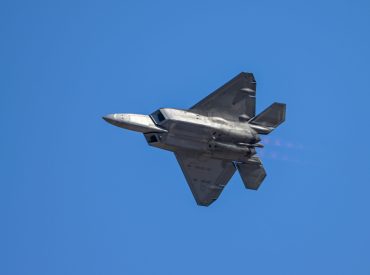US defense contractor Lockheed Martin has revealed a new tailless manned tactical jet concept, signaling a potential significant shift in design and strategy for the US Air Force’s Next Generation Air Dominance (NGAD) sixth-generation fighter program.
Lockheed Martin’s Skunk Works, known for its cutting-edge aerospace designs, revealed the concept while acknowledging it was not a definitive design for the program, The Warzone reported, noting it has a similar wing shape and planform to previous NGAD-related posts.
The Warzone mentions features including a “stinger” tail with a 2D exhaust, similar to the F-22 Raptor, suggesting a design focus on low observability and reduced infrared signature.
The concept aircraft’s large, faceted bulges on the fuselage raise questions about their function, possibly providing internal volume without compromising performance or stealth. The Warzone notes that the design’s huge canopy is striking and hints at a two-crew configuration.
The report says that particular feature may suggest a shift towards aircraft serving as forward battle management nodes, although it could also impact fuel and payload capacity. The Warzone says the concept showcases Lockheed Martin’s broader focus on next-generation unmanned systems and innovative aerospace solutions.
While there has yet to be a consensus on sixth-generation fighters’ defining features, it will likely feature new technologies such as machine learning, artificial intelligence, modular design, directed energy weapons, virtual and augmented reality and optionally manned capability.
The NGAD is set to replace the F-22 as the US Air Force’s premier fighter aircraft by the 2030s. While the F-22 is touted as one of the most capable fighters, issues such as high costs, limited airframe numbers, aging stealth technology and increasingly unfeasible upgrades might have made designing an all-new fighter more logical than keeping the late 1990s airframe aloft.

According to a June 2022 US Congressional Research Service (CRS) report, the NGAD might not be limited to a conventional fighter jet but could encompass various systems including manned, unmanned, optionally manned, cyber and electronic components.
The CRS report says the NGAD aims to redefine air dominance, moving away from traditional military airpower concepts and technologies. For example, the report says that the NGAD may not maneuver like a conventional fighter but could dominate airspace with directed energy weapons powered by multiple engines.
In terms of planned numbers, John Tirpak notes in a March 2023 Air & Space Forces Magazine article that the US Air Force plans to field 200 NGAD airframes alongside 1,000 Collaborative Combat Aircraft (CCA) and request funds in the 2024 fiscal budget to finance these acquisitions.
Tirpak mentions that the number assumes two CCAs will be assigned for each NGAD and two for 300 F-35s. He says that as many as five CCAs could collaborate with each manned fighter, performing electronic warfare missions, suppressing enemy air defenses and providing air and ground protection and communications.
That force configuration belies the US approach to a perceived Chinese anti-access/area denial strategy (A2/AD) over the Taiwan Strait and South China Sea.
In an article this month for Business Insider, Christopher Woody notes that China’s military has spent decades building up its air defenses, emplacing formidable defenses on land and sea, and thus posing a severe problem for US forces.
Woody notes that China has built the world’s densest and most integrated air defense system along its east coast as part of a counter-intervention strategy against the US and its allies in a potential Taiwan conflict and intends to fight under that air defense umbrella.
He mentions that China’s surface-to-air missiles (SAM) aboard its Type 055 cruisers and Type 052D destroyers are more potent than any system currently fielded in Ukraine and that the same formidable systems on land are paired with jamming and electronic warfare capabilities.
In an August 2023 RAND article, Jim Mitre and Ylber Bajraktari note that China has a variety of sensors and weapon systems that can strike US and allied forces during a potential invasion of Taiwan. Mitre and Bajraktari note that the main challenge for the US and its allies is to disrupt China’s targeting capabilities.
In line with the NGAD and CCA programs, they note that large numbers of low-cost, unmanned drones such as the CCA would confuse China’s battlespace awareness and complicate its ability to identify high-value targets such as the NGAD.
They note that drones such as the CCA can act as a force multiplier, drawing Chinese forces to incorrect locations or causing them to expend advanced missiles on false targets.
Mitre and Bajraktari say that the algorithmic optimization of decoys could alert friendly units when they are under surveillance and inform the use of physical, electronic and cyber decoys as well as cover, camouflage and other force maneuvers.
In that direction, the CCA can extend NGAD sensor ranges, acting as advanced surveillance and targeting platforms in defended airspace. At the same time, the NGAD maintains electronic silence and launches standoff munitions from outside the range of enemy air defenses while staying undetected.

However, in an April 2023 War on the Rocks article, Maximilian Bremer and Kelly Grieco note that an offensive air dominance strategy entailing the penetration of heavily defended airspace may weaken US deterrence due to strong Chinese air defenses and the use of non-expendable air assets while running serious escalation risks.
Instead, Bremer and Greco advocate a defense air denial strategy limiting China’s ability to gain and exploit air superiority. Such a strategy, they note, economizes force by employing sufficiently large numbers of smaller, cheaper weapons in a distributed way, aiming to survive initial air and missile strikes and then keeping airspace contested.
They mention that an air denial strategy can dissuade an adversary from launching an amphibious invasion if the defender can sustain the attrition rates.

